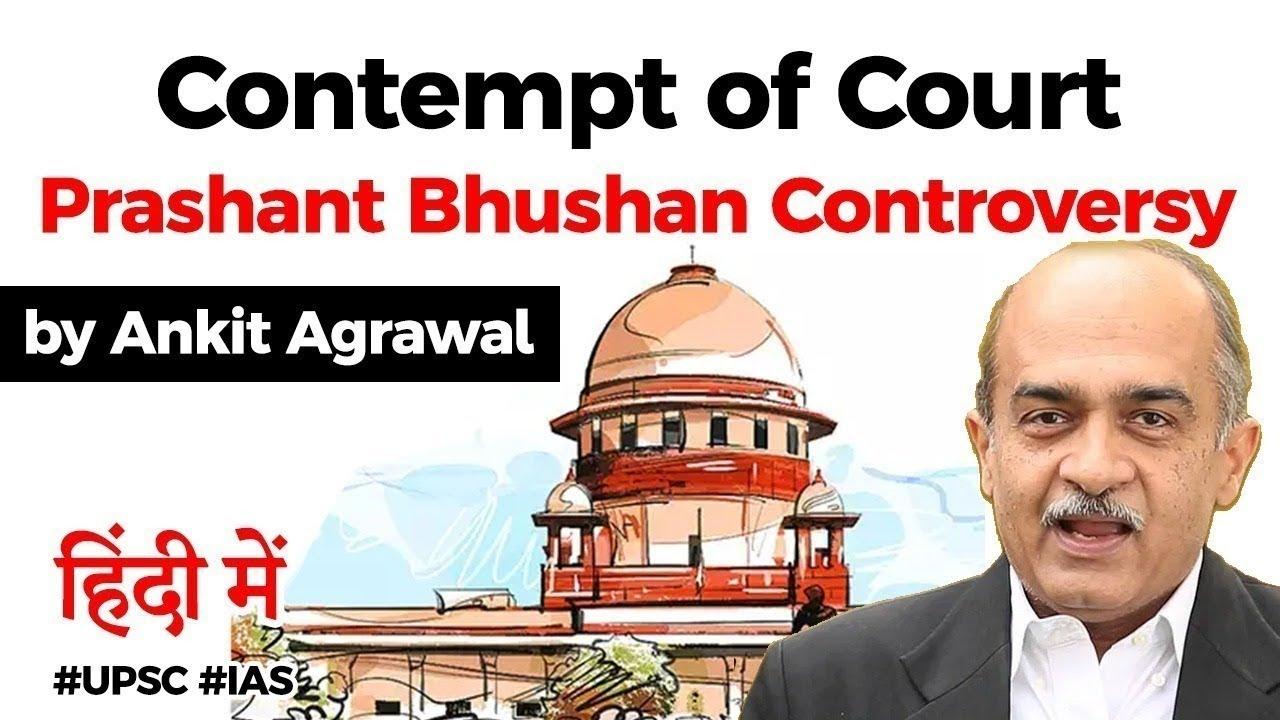Table of Contents


- The Supreme Court on Wednesday initiated suo moto contempt proceedings against lawyer
- Prashant Bhushan.
- On Wednesday, the Supreme Court bench of Justices
- Arun Mishra, B.R. Gavai and Krishna Murari issued a notice for contempt of court for two tweets he recently posted.

- “We are, prima facie, of the view that the aforesaid statements on Twitter have brought the administration of justice in disrepute and are capable of undermining the dignity and authority of the institution of Supreme Court in general and the office of the Chief Justice of India in particular, in the eyes of public at large.”
- The case is scheduled for hearing on August 5.
What is Contempt of Court?
- Any conduct that tends to bring the authority and administration of law into disrespect or disregard is considered to be contempt of court
The Contempt of Courts Act, 1971
- In India, the Contempt of Courts Act was passed in 1926.
- It was enacted to define and limit the powers of certain courts in punishing contempt of courts.
- Various Indian States like Hyderabad, Madhya Bharat, Mysore also had their corresponding enactment.
- Many of them were replaced by the Contempt of Courts Act, 1952
Committee on Contempt of court
- To define and limit the powers of certain courts in punishing contempt of courts and to regulate their procedure,
- A Committee was set up on 29th July, 1961 and it submitted its report on 28th February,1963.
- Joint Select Committee of Parliament on Contempt of Courts went in detail and a new Bill,
- The Contempt of Courts Bill, 1968 was prepared by the Joint Select Committee.
- The Contempt of Courts Act, 1971 was passed by the Parliament in December 1971.
- The legislature does not provide with a concrete definition of contempt.
- However section 2(a) of The Contempt of Courts, 1971 says,
- Contempt of court means civil contempt or criminal contempt.
- According to section 2(b) of the Contempt of Courts Act, 1971 civil contempt means-
- Willful disobedience to any judgement, decree, direction, order, writ or other process of a court or willful breach of an undertaking given to a court.
- According to section 2(c) of The Contempt of Courts Act, 1971, criminal contempt means-
- The publication (whether by word, spoken or written, or by signs, or by visible representation, or otherwise) of any matter or the doing of any other act whatsoever which-
i) Scandalizes or tends to scandalize, or lowers or tends to lower the authority of, any court, or
ii) Prejudices or interferes or tends to interfere with the due course of any judicial proceeding, or
iii) Interferes or tends to interfere with, or obstruct or tends to obstruct, the administration of justice in any other manner.
- The 21st Law Commission under Justice B.S. Chauhan(retd.) was established in 2015.
- It submitted its report on the Contempt of Courts Act, 1971.
- The report concluded that there was no requirement to amend the Act.
Reasons
- High number of contempt cases: The Commission observed that there were a high number of civil (96,993) and criminal (583) contempt cases pending in various High Courts and the Supreme Court.
- International comparison: United Kingdom had abolished the offence in its contempt laws. But Scandalising the Court continues to be punishable in UK under other laws.
- Impact on subordinate courts:The Act additionally allows the High Court to punish for contempt of subordinate courts.
- The Commission also noted that there are several safeguards built into the Act to protect against its misuse.
- For instance, the Act contains provisions which lays down cases that do not amount to contempt and cases where contempt is not punishable.
Latest Burning Issues | Free PDF






















 WhatsApp
WhatsApp